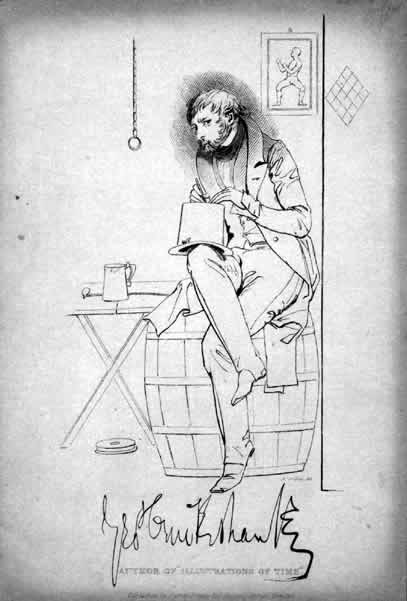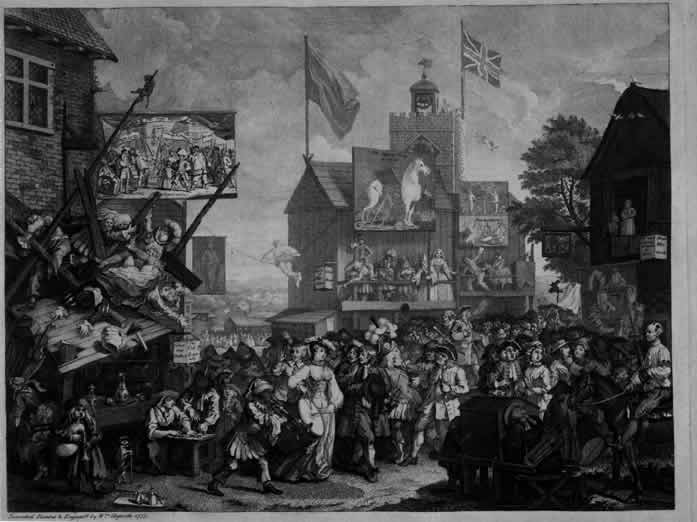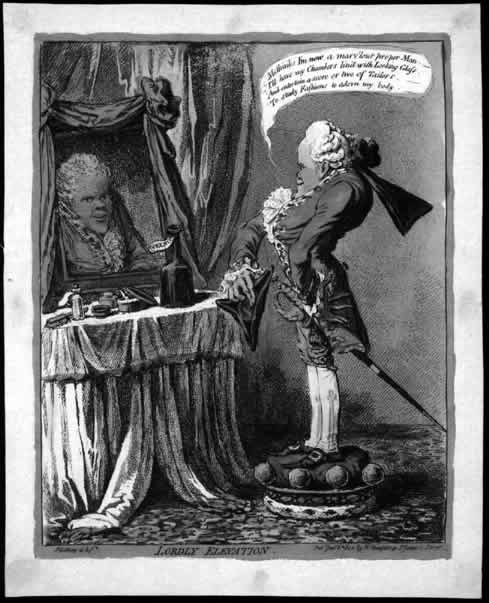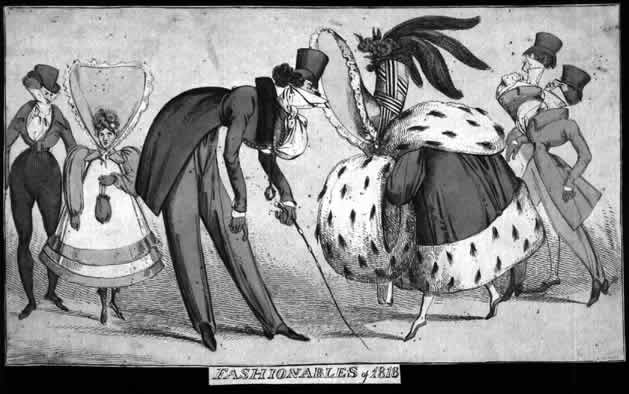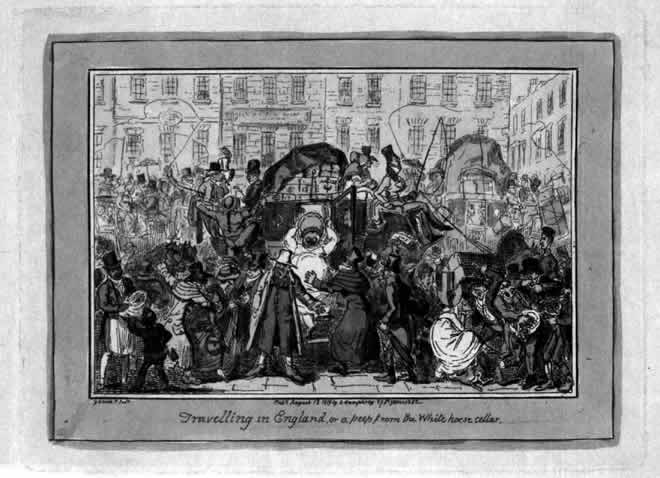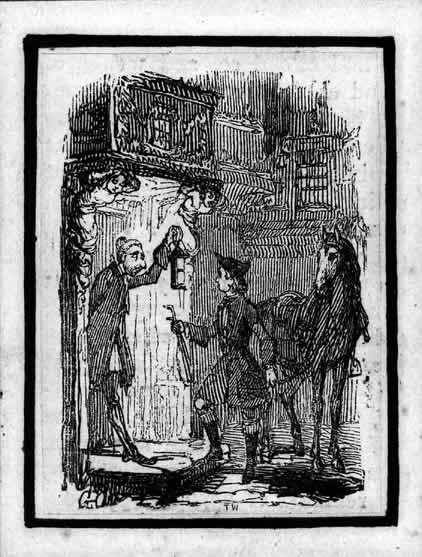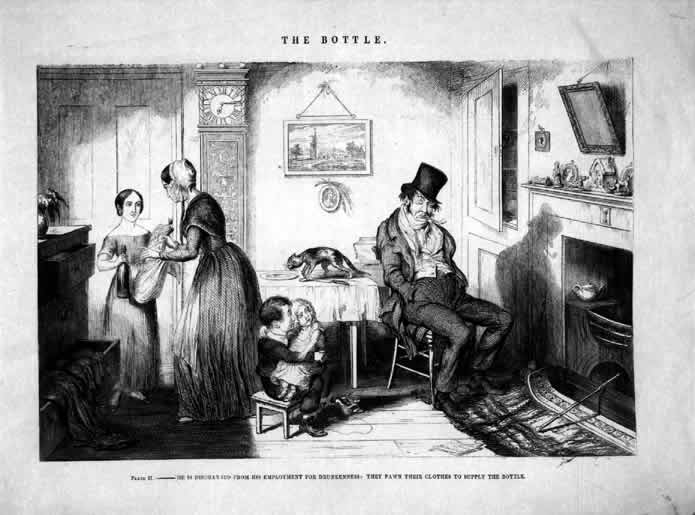Cruikshank on Paper
by Ted StanleyPresented at the Book & Paper Group Session, AIC 28th Annual Meeting, June 8-13, 2000, Philadelphia, Pennsylvania. Received for publication Fall 2000.
Abstract
George Cruikshank is the most noted English graphic illustrator and caricaturist of the nineteenth century. He followed in the footsteps of the great satirical graphic artists before him, Hogarth and Gillray. Cruikshank's distinctive works on paper first centered around English politics as he ridiculed the Whigs and Tories of his day. He later cast his talent toward creating illustrations for books as well as championing social causes. Through his intense energy and fertile imagination Cruikshank produced about five thousand works during his lifetime. This paper presents a brief sketch of the life and artistic talents of Cruikshank. In particular, this paper looks at samples of his work found in the collections of Princeton University Library.
Introduction
Whenever a person or society imposes unfair or oppressive rules and regulations or takes pompous views that may be construed as being holier than thou, the caricaturist will strike. Caricaturists attempt by drawn line and sharp wit to say to the public that "the king has no clothes." Historically they have been, in some respects, the conscience of a society, taking pot shots at the most visible and the most powerful members of the community. The word caricature is derived from the Italian verb caricare, meaning "to load" or "to surcharge," as with exaggerated detail, and was first used by Mosini in a work called Diverse Figure (1646). Thus, the actual word caricatura appeared in Italy during the seventeenth century (Lynch 1926). Caricature spread from Italy and France to England in the eighteenth century. Caricature's satirical cutting edge was masterfully used by the British caricaturist James Gillray (1756-1815) in the late eighteenth and early nineteenth centuries to bring to the forefront the shortcomings of England's political and social systems. When the word caricature first appeared in England it was generally used by print shops to describe any print with a comic or satirical intention. Early in the eighteenth century the word caricatura was rarely used because its exact meaning was little understood. The word hieroglyphics was used instead to describe satirical drawings (Lynch 1926).
The most prevalent forms of satire were political and social in content. Now it is more loosely identified with certain graphic artists of the early period such as Hogarth, Gillray, and Rowlandson (George 1967). Heads of state, fashionable dress, city life, rural life, transportation, and the many ironies of life that come about are just a few of the long list subjects inked onto paper for the amusement and sometimes enlightenment of the populace. George Cruikshank, a follower of Gillray's work, was the next in line to use his supreme wit and great graphic talent to push the caricaturist's boundaries for political and social good. This paper will serve to highlight the life of George Cruikshank and his place in the history of British caricature. It will also examine some samples of his work found in the Graphic Arts Collection of Princeton University Library.
The Cruikshank Collection at the Princeton University Library
Fig. 1. A. Croquis, George Cruikshank, 1882, printed sketch, 22.6 x 14.6 cm. Princeton University Library (visual 548).
Cruikshank was a very prolific graphic artist (fig. 1). He produced more than five thousand works during his lifetime (Hill 1992). It has been noted that Princeton University owns the finest collection of Cruikshankiana outside of England. According to E. D. H. Johnson (1973-74) in the Princeton University Library Chronicle, the nucleus of the Cruikshank Collection was formed by Richard Waln Meirs, class of 1888. The material came to the university in 1913. The collection grew with the addition of material donated by Gordon A. Block, Jr., '36, and A. J. Rosenfeld. The library has also purchased a substantial body of work. Johnson (1973-74) estimates that in 1943 the Meirs Collection held about one half of the 863 illustrated books listed in Albert M. Cohn's 1924 Catalogue Raisonné of the Printed Works Illustrated by George Cruikshank. The Catalogue Raisonné is one of the most definitive sources on Cruikshank ever published. The publication covers the period from 1806 to 1877 and includes many of Cruikshank's choice works. The collection at Princeton also holds approximately five hundred caricatures and broadsides (Johnson 1973-74). In addition to the prints and illustrated books in the collection there are numerous sketches and drawings, printing plates and woodblocks, several oil paintings, and even a panorama box.
George Cruikshank and Early English Caricature
George Cruikshank was born September 27, 1792. His parents, Isaac and Mary Cruikshank, migrated to London from Scotland. Isaac Cruikshank (1756?-1811) was a renowned graphics illustrator in his own right. George was one of five children born in his family. Only he and his brother Robert (1789-1856), who became a noted graphic artist himself, survived into adulthood. Cruikshank was educated in the schools of central London. From all accounts he had a happy childhood and affectionate parents. He helped his father with his work and began to master the various parts of what it took to produce a polished print. But Cruikshank wasn't ready to try his hand seriously as a graphic artist yet. Besides trying to become a seaman, Cruikshank worked as a law clerk, but that bored him. He continued exploring various occupations including acting. Then he came to realize that his only true talent was as a graphic artist. When his father died in 1811 he had committed himself at age 18 to becoming a full-time graphic artist.
The apt phrase "timing is everything" certainly applies to Cruikshank and his destiny to become the most instrumental graphic artist of his time. Toward the end of the eighteenth century forces in the art world and society were beginning to change and would ultimately influence Cruikshank as an artist, technically, and his ideas, philosophically. The long-cherished engraving was giving way to etching for producing popular prints. It has been noted that in the 1770s London publishers were supplying one hundred etched caricatures per year, but this figure more than doubled in the 1820s to around 250 (Hill 1992). There were numerous social and political events and changes at home and abroad that Cruikshank reflected upon in his work. The activities of Napoleon I and the members of the British parliament were often targets of Cruikshank's wit and genius.
The middle-class and provincial consumers had developed a taste for this type of artwork and were buying prints. Prints were sold singly, colored and uncolored. Consumers could also rent portfolios by the day from print sellers (Hill 1992). The public appetite for information about the world around them was insatiable. And everyone wanted a good laugh whether it was poking fun at royalty, society, or politicians.
Fig. 2. William Hogarth, Southwark Fair, 1733, engraving, 44.5 x 51.5 cm. Princeton University Library (record id: 12983).
Fig. 3. James Gillray, Lordly Elevation, 1802, hand-colored etching, 24 x 29.7 cm. Princeton University Library (visual 3285). Here Gillray makes light of one's indulgence in self-flattery.
Graphic artists of the Regency period (1800-1830) and later the Victorian era (1837-1901) were influenced to a large extent by late eighteenth-century graphic artists William Hogarth (1697-1764) and John Gillray. Hogarth's forte was presenting a true unvarnished view of everyday life in England with moral overtones through his engravings. In his engraving Southwark Fair, one of his more popular and famous works, he captures well the gaiety of a local event (fig. 2). Gillray stretched artistic license through his unique and new brand of satirical art, which examined the excesses of politics and the social norms of his day (fig. 3). There was such admiration for Gillray's work that his style was imitated by graphic artists from all over Europe during the Napoleonic era of the early 1800s (Veth 1930). He was indeed the preeminent master of caricature.
Cruikshank: the Artist
According to Hill (1992) Cruikshank practiced what is called Regency caricature. Regency caricature was a collaborative effort that involved formulating an idea, executing a representative drawing, and producing the print. The majority of the ideas for Cruikshank's prints came from others (Vogler 1979). This was especially so when Cruikshank was a free-lance artist between 1811 and 1826. During this period he worked for over a hundred publishers producing an estimated two thousand prints, but only with about two dozen did he have a regular association (Hill 1979). As was the convention during his time, Cruikshank's completed works were no longer his upon their publication and even his plates became the property of the publishers (Hill 1979). This bothered Cruikshank, and when he later became a book illustrator he tried publishing for himself. The hundreds of prints that Cruikshank produced were sold colored and uncolored. The printing and hand coloring were done under the auspices of the publisher. One can see throughout the body of Cruikshank's work that the quality of the printing, hand coloring, and paper varied from publisher to publisher. Some obviously took great care in producing Cruikshank's work while others did not. For instance, some publishers were very particular in the manner in which copies of the same print were colored. They saw to it that copies were neatly and consistently tinted with the same color. Other publishers were not as fastidious and used inferior papers and shoddy printing methods. Sometimes copies of the same print were hand colored differently. Often publishing houses had their own unique style of caricature that they would want the artist that they commissioned to use. For instance, the Humphrey publishing house incorporated the Gillray style, which Cruikshank used for them. Cruikshank used the style reminiscent of Thomas Rowlandson for the Tegg publishing concern since they published much of his work.
Despite these attempts by the publishing houses at stylization, Cruikshank's own unique persona came through as the very recognizable hand that drew the lines. Cruikshank's work is both devilishly humorous and poignant. The imagery is very stylized—very Cruikshank one might say. One knows a Cruikshank immediately upon first sight. The dynamic elements that Cruikshank brought together so successfully in his work has caused some to refer to him as "the greatest comic etcher that ever lived" (Cohn 1924).
Fig. 4. George Cruikshank, Fashionables of 1818, 1818, hand-colored etching, 21 x 34.5 cm. Princeton University Library (visual 103). Cruikshank employs a standard technique of caricaturists with his use of exaggerated line.
Fig. 5. George Cruikshank, Travelling in England or A Peep from the White-horse Cellar,1819, hand-colored etching, 22.2 x 18.6cm. Princeton University Library (visual 323). In this print Cruikshank's satirical wit and imagery focuses upon the difficulties that a person encounters in dealing with the daily routine of moving about among the urban masses.
Typically political or social in nature, Cruikshank's caricatures touched a wide range of issues, circumstances, and facets in everyday life. The relevance of his subject matter has not changed much in 150 years. In one of his works, The Fashionables, 1818, he used exaggerated line beautifully to compliment the drawing and cleverly added a humorous effect to the imagery (fig. 4). In another example called Travelling in England, or A Peep from the White-horse Cellar, Cruikshank recreates wonderfully the chaos and mad jumble of urban transport in congested city streets, which at first glance appear as true today as then (fig. 5).
Fig. 6. A wood engraving, 7 x 5.4 cm, by George Cruikshank for W. H. Ainsworth's The Miser's Daughter: A Tale, 842, London: Cunningham and Mortimer. Princeton University Library (acc. no. E2845).
Cruikshank's favorite medium was etching, and he executed these himself (Hill 1979). His early works were produced from copper plates. An acid-resistant ground was applied to a copper plate, and he would then draw an image with a needle. The plate was then plunged into nitric acid. The acid then ate into the exposed areas of the plate. Cruikshank was also a gifted wood engraving designer as well (fig. 6). Wood engravers of the period were followers of the late eighteenth-century artisan Thomas Bewick (1753-1828), who himself apprenticed under Ralph Beilby in 1767. These engravers set the standard for the day that involved a very high degree of technical skill and the ability to faithfully represent an artist's drawings in woodcut. According to Hodnett (1988), Bewick demonstrated that engraving in relief on blocks that were the same height as the type was the practical way to circumvent the high cost of copper-engraved book illustrations. Bewick also used fine-grain boxwood cut across the grain, which far outlasted metal engravings and etchings. John Thompson (1785-1866), Ebeneser Landells (1808-1860), and John Jackson (1801-1848) were among the wood engravers that Cruikshank commissioned to faithfully produce his work using some form of Bewick's wood engraving method. It must be further noted that Bewick has been credited with having great influence on the revival of illustration (Veth 1930). Cruikshank also issued large sets of proofs using the chine-collé technique for separate sale (Johnson 1973-74). Typically India paper was used for producing chine-collés. India paper is more commonly known as China paper today (Krill 1987). The very thin paper was made of short-fibered cotton. Cruikshank also made hundreds of sketches and drawings, watercolors, and a number of oil paintings.
In a cursory examination of Cruikshank's prints in the collection at Princeton one finds that wove paper appears to be the predominant support, such as one example found with a Smith & Nutt 1816 watermark. Wove paper came into popular use for printing from copper plates in the late 1700s, when around 1768 James Whatman II realized that the paper's even surface was much more suited to printmaking than laid paper, which was the standard of the day (Hills 1988). Interestingly, I did manage, by chance, to come across one print in the collection that was made on laid paper. It is an 1815 Whatman laid paper. It has been noted that some of Cruikshank's London publishers, such as George Humphrey, usually printed on Whatman paper (Vogler 1979). The majority of the papers are most likely wove.
I also examined the fiber content of about a dozen papers dated between 1813 and 1829 and an additional paper made around 1851. Most of the papers examined are made of cotton fibers. Two papers contain flax fibers and one has what appears to be an even mixture of both cotton and flax. It should be noted that cotton fibers began to be introduced for printmaking in the late 1700s when it was noticed that the twist of the cotton fiber produced bulk and opacity as well as softness (Hills 1988). This fiber characteristic is perfect for printing from copper plates, so cotton was added to the linen furnish to improve its printing quality. The rags in general needed very little preparation such as washing and bleaching. Upon inspecting the materials in the Cruikshank collection such as his prints, drawings, watercolors, and impromptu sketches one can see that they were produced on a wide range of papers that vary in color, texture, and thickness. The examination of only a dozen papers is not sufficient to draw any well-founded conclusions about the true nature of the fiber content of the papers in the collection. But, hopefully, a more thorough investigation on this matter will take place in the future.
Cruikshank the Book Illustrator
Cruikshank began his venture into book illustration in1823 with the publication of The Humourist. The majority of the work that he produced from about 1830 to 1845 was in fact book illustration. During this period many of the novels that he illustrated were published in serial form. He produced extensive work for Bentley's Miscellany and later Ainsworth's Magazine. Cruikshank's relationship with Bentley's became unpleasant, and he began to produce poor work for the serial just so he could break from it. It has been thought that Cruikshank plunged into book illustration to truly unleash his talent for humor and to address social ills in his own personal and unique style of commentary. But it must also be said that Cruikshank's eccentric personality is legendary and made it very difficult for him to work congenially with almost anyone.
The publication that brought his talents to the forefront for public view was Point of Humour, which was issued in two parts between 1823 and 1824 by Charles Baldwyn of Newgate Street. Cruikshank's illustrations found their way into many children's stories, such as Cinderella, Robinson Crusoe, Punch and Judy, and others. Cruikshank also did work for other types of popular novels such as Tom Jones.
Perhaps Cruikshank's most celebrated and noteworthy collaboration was with Charles Dickens in the publication of the serialized Oliver Twist in 1838. As the popularity of the novel grew, the relationship between artist and author became more and more strained under the pressures of making publication deadlines. Both had strong wills and opinions about how to develop the novel, and there was a constant battle for control of the project—which would determine where the creative emphasis would lie: text or illustration? Cruikshank completed his work on Oliver Twist, and his illustrations received high praise. But the project left him disillusioned and bitter.
The relationship with Dickens was almost typical of most of Cruikshank's creative collaborations throughout his career. He often felt cheated and taken advantage of, never receiving the credit and acknowledgment that he thought he rightfully deserved. Like Hogarth before him, Cruikshank felt an unpleasant dependence on booksellers. He felt that the only way to be free was to publish his work independently.
Some of Cruikshank's self-published works were Phrenological Illustrations, 1826; Scraps and Sketches, 1829; and My Sketch Book, 1834. Cruikshank's publications not only allowed him to enjoy artistic freedom, but they also allowed him to attack those that angered him. For instance, one publisher used the Cruikshank name without noting that the work was by Robert and not George. Cruikshank is shown pulling the nose of the offending publisher in one of his later works (Hill 1992).
Cruikshank also used his publications to champion social causes and bring to public light what he perceived were acts of negative behavior, such as drinking alcohol. In his famous publication The Bottle Cruikshank illustrates the terrible repercussions that drinking can have upon a family. Cruikshank's harsh view on the subject is not surprising. He was one of the most active and vocal proponents of the Temperance Movement in nineteenth-century England. Some of the more chilling and sobering of Cruikshank's illustrations are to be found in Maxwell's History of the Irish Rebellion in 1798. These illustrations, similar to the work of Goya, show the cruelty and inhumanity found in war.
One of Cruikshank's most successful illustrated books is his series The Comic Almanack, which was published from 1835 to 1852. It contains an etched plate for each month adorned with small decorations and vignettes in woodcut. About 250 etchings were produced during its issue (Katanka and Rickwood 1973). The plates are depictions of everyday life in London. The images are Cruikshank's own satirical commentary on a wide range of social and environmental issues.
Fig. 7. George Cruikshank, The Bottle, Pl. II, 1849, glyphograph, 29 x 42 cm. Princeton University Library (Cruik 1849.2)
Cruikshank was indeed a very prolific book illustrator and he utilized a variety of printing techniques for publishing his works. Though Cruikshank had a fondness for copperplate etchings he later grew to love works executed by etching on steel, which were not only durable but were capable of producing prints with greater tonality and finesse of line. Cruikshank also produced some mezzotints as well. According to Bamber Gascoigne in his How to Identify Prints publication (1995), glyphography, the generic term for wax engravings, was also used by Cruikshank in his book illustrations (fig. 7). Etching on glass, cliché verre, was another type of printing technique that he used. His interest in the use of various types of printing techniques later in life may have been spurred by the possibility of producing more illustrations cheaper (Vogler 1979).
Cruikshank's fame and fortune dimmed as his later years passed, although he was considered the greatest English artist of the nineteenth century by his contemporaries. By his own account commissions declined substantially to almost nothing between 1860 and 1875 (Osbert and Sitwell 1938). Cruikshank suffered from palsy late in life. Through these years, though difficult and tough, Cruikshank retained his legendary energy and his sometimes acrid personality. His last published work was in 1875, and he died three years later in 1878.
Conclusion: Remembering Cruikshank
This very brief discussion of the works of George Cruikshank in the collections of the Princeton University Library hardly scratches the surface of the artist's unique wit and character. Such was Cruikshank's profound affect during his lifetime that a George Cruikshank school of illustration emerged with graphic artists Robert Seymour (1800-1836), Alfred Crowquill, and Kenny Meadows (1790-1874) among its ardent followers (Veth 1930).
When one views today the editorial section of any city newspaper and chuckles at the caricature of a politician who has fallen from grace or simple everyday activities seen in a more endearing light one must think to Cruikshank and the trail that he blazed. George Cruikshank's death in London in 1878 left a large void for others to fill.
acknowledgment
I wish to express many thanks to Agnes Sherman, Special Collections Assistant, Graphic Arts Collection, Princeton University Library, for her invaluable assistance in this project.
References
Cohn, A. M. 1924. George Cruikshank: a catalogue raisonné of the work executed during the years 1806-1877. London: The Bookman's Journal.
Gascoigne B. 1995. How to identify prints: a complete guide to manual and mechanical processes from woodcut to ink jet. New York: Thames and Hudson.
George, M. D. 1967. Hogarth to Cruikshank: social change in graphic satire. London: Penguin Press.
Hill, J. E. 1992. The genial genius of George Cruikshank (1792-1878): a bicentennial exhibition, Sept. 27-Nov. 10, 1992. Minneapolis, MN: Special Collections & Rare Books, Wilson Library, University of Minnesota.
Hills, R. L. 1988. Papermaking in Britain, 1488-1988 : a short history. London and Atlantic Highlands, NJ: Athlone Press.
Hodnett, E. 1988. Five centuries of English book illustration. Aldershot [Hampshire]: Scolar Press.
Johnson, E. D. H. 1973-74. The George Cruikshank collection at Princeton. The Princeton University Library Chronicle (Princeton, NJ) 35(1 & 2):1-34.
Katanka, M., and E. Rickwood. 1973. Gillray and Cruikshank: an illustrated life of James Gillray (1756-1815) and of George Cruikshank (1792-1887). Aylesbury, UK: Shire Publications.
Krill, J. 1987. English artists paper: Renaissance to Regency. London: Trefoil Publications Ltd.
Lynch, B. 1926. A history of caricature. London: Faber and Gwyer.
Osbert, E., and S. Sitwell. 1938. Trio: dissertations on some aspects of national genius. London: MacMillan & Company.
Veth, C. 1930. Comic art in England. London: Edward Goldston.
Vogler, R. A. 1979. Graphic works of George Cruikshank. New York: Dover Publications.
Ted StanleyPreservation Office
Princeton University Library
Publication History
Received: Fall 2000
Paper delivered at the Book and Paper specialty group session, AIC 28th Annual Meeting, 8-13, 2000, Philadelphia, Pennsylvania.
Papers for the specialty group session are selected by committee, based on abstracts and there has been no further peer review. Papers are received by the compiler in the Fall following the meeting and the author is welcome to make revisions, minor or major.
